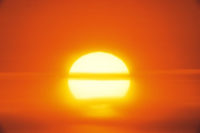Michaels enlists meteorologists in heat warning campaign
"His death was entirely preventable"

 Dr. David Michaels, Assistant Secretary of Labor for Occupational Safety and Health recently spoke to meteorologists and weather forecasters about OSHA's Heat Stress Awareness Campaign:
Dr. David Michaels, Assistant Secretary of Labor for Occupational Safety and Health recently spoke to meteorologists and weather forecasters about OSHA's Heat Stress Awareness Campaign:
Today is one of those days when I know many of you are reporting high temperatures in cities around the country.
We are only in the first days of summer, but already many cities across the country – including here in Washington, D.C. – have experienced very hot days. And, I don't need to tell you, there is a scorching heat wave in the Southwestern parts of the United States.
Every part of the country
Whenever there is high heat, outdoor workers are at increased risk for heat-related illnesses and deaths. In fact, every year thousands of workers experience heat-related illnesses, and dozens more are killed by heat, and it happens in every part of the country.
This is why the Department of Labor has launched a nationwide awareness campaign for the last two years to keep outdoor workers safe on the job.
It's critical that we work together again this summer to get the word out that working in high heat can be deadly.
Here's just one example: Last summer in New Jersey, a 47-year-old sanitation worker started showing signs of illness while he was working. He had begun work at 6:30 in the morning and by 3:30 the temperature was 93 degrees.
He collapsed and was rushed to the hospital where his internal body temperature had reached 106.9. He died of heat stroke. His death was entirely preventable.
Training is vital
OSHA's investigation determined that his employers failed to ensure that their workers consumed enough fluids and failed to properly train their employees on how to recognize and respond to the signs of heat stress.
We've already seen several heat-related fatalities this year and we really don't want to see any more. You can help: We're asking you to share our campaign's simple three-word message: Water. Rest. Shade. If outdoor workers take these precautions, it can mean the difference between life and death
The workers most at risk for heat-related illness are in construction and agriculture, but there are many outdoor workers in other industries who are at increased risk as well. These include workers in transportation, sanitation and recycling, building and grounds maintenance, landscaping services, oil and gas operations, and anyone else who does strenuous work in the open air.
We need your help to get the word out to employers that they are responsible for providing workplaces that are safe from excessive heat. This means regular breaks for workers so they can cool down. It means regular access to water so workers can stay hydrated. It means training for workers on the symptoms of heat illness – and what to do if they see a co-worker showing signs of dehydration or heat stroke.
OSHA has five key pieces of advice:
- One: Drink water every 15 minutes, even if you're not thirsty.
- Two: Rest in the shade to cool down.
- Three: Wear a hat and light-colored clothing.
- Four: Learn the signs of heat illness and what to do in an emergency.
- Five: Keep an eye on fellow workers.
You probably know that the National Weather Service now includes worker safety information in all its extreme heat alerts and important worker safety information is now included on NOAA's Heat Watch page. We are grateful to the National Weather Service and the National Oceanic and Atmospheric Administration for their partnership.
Since we launched our Heat Illness Prevention Campaign two summers ago, we have reached more than 7.5 million workers and employers. We have held thousands of events, trainings, and presentations; and we've distributed nearly 500,000 posters, factsheets, and other educational materials in English and Spanish.
Newbies at greatest risk
We've found that, generally, the workers who are most at risk for heat-related illnesses are those who are new to outdoor jobs – especially temporary workers. Once a worker is acclimated to heat, the risk is lower.
Seasonal workers can be considered new even if they have been working every season for several years. Gradually increasing the workload and giving workers time to acclimate allows them to build tolerance to the heat. This is critically important for workers who are new to working outdoors in the heat, who have been away from working in the heat for a week or more, or at the beginning of a heat wave.
Employers need to be especially concerned about these workers in the heat, but they must make sure that everyone is protected with Water, Rest, and Shade – whether a worker has been on the job one day or 25 years.
Signs and symptoms
Sometimes referred to as "heat stress," what we are really talking about is the range of heat illnesses that a person can experience if the right precautions aren't taken when working outdoors. It can mean an increase in:
- body temperature
- blood pressure
- breathing rate, and
- sweating, or dizziness, confusion etc.
The two most important illnesses to watch out for are heat exhaustion and heat stroke.
Heat Exhaustion. Symptoms include: headache, nausea, dizziness, weakness, thirst and heavy sweating. It can turn into heat stroke quickly if immediate action is not taken.
Heat Stroke is the most serious heat-related illness and requires immediate medical attention. Symptoms include: confusion, fainting, seizures, very high body temperature and hot, dry skin or profuse sweating. The visible signs of heat stroke are red, hot, dry skin or excessive sweating, confusion, seizures and fainting.
In both cases, a person may not recognize the signs themselves, so it very important to look for signs in coworkers and companions. We tell workers to take heat exhaustion very seriously and stop for first aid before it becomes heat stroke. If possible, have a buddy system to help monitor yourself and coworkers.
Free Osha resources
A central element of the campaign is our updated OSHA Heat Campaign webpage (available in English and Spanish), which provides access to the online tools and resources on our webpage at www.OSHA.gov.
Several of our most popular resources include the illustrated low-literacy fact sheet and a workplace poster – released in both English and Spanish and focused on reaching workers with limited English proficiency – as well as the OSHA Heat Illness Prevention Training Guide, which includes information in short, interactive lesson plans that can be completed in a tailgate or toolbox talk.
We also have two resources developed in coordination with the National Weather Service, which use the Heat Index as a trigger for employers and workers:
The Heat Index Guidance for Employers is designed to help employers and worksite supervisors prepare and implement hot weather plans. It explains how to use the heat index to determine when extra precautions are needed at a worksite to protect workers from environmental contributions to heat-related illness. The resource defines four risk levels and outlines specific steps employers should take to reduce the risk of heat illness. It includes detailed information to employers about how to establish work/rest schedules, acclimatize workers, conduct training, and monitor workers for heat illness as well as checklists for planning.
The heat smartphone app can help employers and workers monitor dangerous heat levels throughout the summer. The "OSHA Heat Safety Tool" app allows you to calculate the heat index for a worksite. The app pulls data directly from NOAA to perform heat index calculations, and based on that index, it displays a risk level and the protective measures that should be taken to prevent heat illness. Through simple action-oriented statements and illustrations, the app provides the user with reminders about the protective measures that should be taken at that risk level to protect workers from heat-related illness, including an option to "Contact OSHA." The app is available on iPhone and Android and has been downloaded more than 72,000 times.
Weather broadcasts can help
Finally, I'd like to ask for your help by incorporating worker safety into your weather broadcasts.
Often when reporting heat-related stories you highlight those most at risk: young children, the elderly, pets. You will be doing a vital public service if you also include outdoor workers as a reminder that they, too, are at risk, especially during heat waves.
Workers often cannot get out of the heat – their work requires them to be exposed daily – and they may not be able to use the advice aimed at the general public. So, calling them out specifically when you announce a heat wave and discussing risk and prevention is important.
Here is the language that is added to the NOAA excessive heat warnings that are sent across the country and which you will receive:
TAKE EXTRA PRECAUTIONS IF YOU WORK OR SPEND TIME OUTSIDE. WHEN POSSIBLE, RESCHEDULE STRENUOUS ACTIVITIES TO EARLY MORNING OR EVENING. KNOW THE SIGNS & SYMPTOMS OF HEAT EXHAUSTION & HEAT STROKE. WEAR LIGHT-WEIGHT & LOOSE FITTING CLOTHING WHEN POSSIBLE & DRINK PLENTY OF WATER.
TO REDUCE RISK DURING OUTDOOR WORK, THE OCCUPATIONAL SAFETY AND HEALTH ADMINISTRATION RECOMMENDS SCHEDULING FREQUENT REST BREAKS IN SHADED OR AIR-CONDITIONED ENVIRONMENTS. ANYONE OVERCOME BY HEAT SHOULD BE MOVED TO A COOL & SHADED LOCATION. HEAT STROKE IS AN EMERGENCY - CALL 911.
OSHA also has compliance assistance specialists throughout the U.S. who are ready to meet with employers, talk about prevention, and provide training on heat illness prevention.
OSHA's staff can also be a resource to you.
A 3-word message
When you are broadcasting severe temperatures this summer, we're asking you to share our campaign's three-word message: Water. Rest. Shade.
If outdoor workers take these precautions, it can mean the difference between life and death.
Anyone overcome by heat should be moved into the shade immediately, and 9-1-1 should be called... because heat stroke is an emergency.
It's my hope that with all of us working together we can build a network of weather broadcasters who can respond quickly to extreme heat and get our message to workers all across our nation when they need us the most.
I have no doubt that by working together, we can save lives.
Looking for a reprint of this article?
From high-res PDFs to custom plaques, order your copy today!




